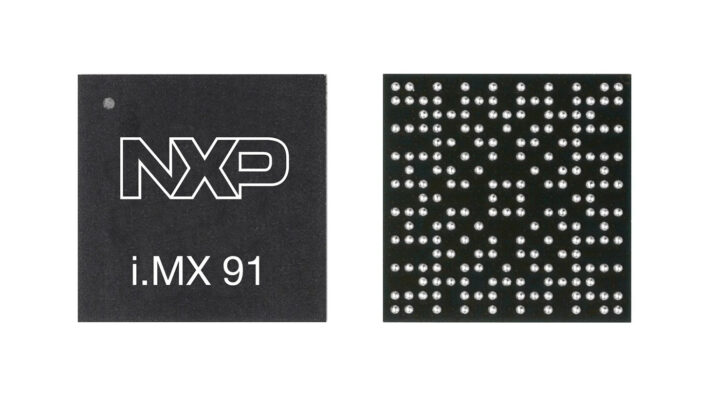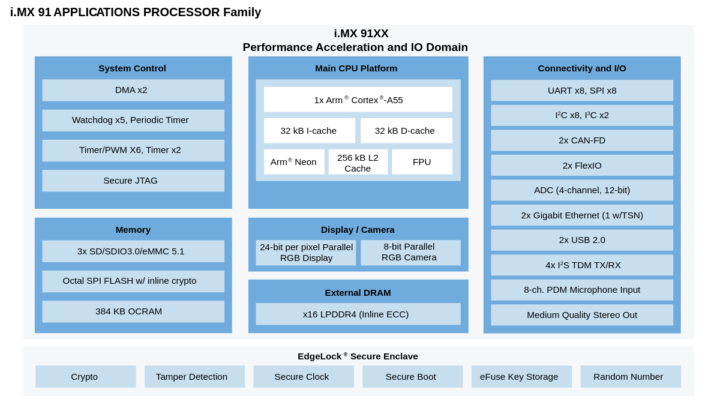NXP has just unveiled the NXP i.MX 91 single-core Cortex-A55 processor following the introduction of the i.MX 93 in 2021, and designed for cost-optimized edge devices running Linux.
The NXP i.MX 93 processor comes with up to two Cortex-A55 cores, a Cortex-M33 real-time core, and an Ethos U65 microNPU, but targeting entry-level Linux systems, the NXP i.MX 91 processor does without the real-time core and the AI acceleration, while still integrating NXP EdgeLock Secure Enclave, and the company highlights support for multiple wireless connectivity options through companion chips such as the IW612 that supports Wi-Fi 6, Bluetooth 5.2, 802.15.4, and the new Matter protocol.
- CPU – Arm Cortex-A55 running at up to 1.4GHz with 256KB L2 cache
- System Memory – Up to 2.4GT/s x16 LPDDR4 with Inline ECC
- Storage
- 3x SD 3.0, SDIO 3.0, eMMC 5.1
- 1x Octal SPI including support for SPI NOR and SPI NAND memories
- Display interface – 24-bit parallel RGB
- Camera interface – 8-bit parallel YUV/RGB
- Networking – 2x Gigabit Ethernet with AVB and IEEE 1588 for sync and EEE for low power, 1x with TSN support
- Audio
- 3x SAI (1x 2-lane, 2x 1-lane), 4x I2S TDM
- 8-channel PDM microphone input
- MQS: Medium Quality Sound output (sigma-delta modulator)
- USB – 2x USB 2.0 Type C with PHY
- Serial
- 2x CAN-FD
- 8x UART/USART/Profibus, 8x I2C, 8x SPI, 2x I3C
- Analog – 8-channel 12-bit ADC
- 2x 32-pin FlexIO interfaces (camera, bus, or serial I/O)
- Process – 16 nm FinFET
- Packages – 11x11mm 0.5 mm pitch, 9×9 mm 0.5 mm pitch
- Temperature Range
- Commercial – 0°C to 95°C
- Industrial – -40°C to 105°C
Supported operating systems include Linux, Green Hills INTEGRITY, and QNX Neutrino. The new processor will be found in industrial (HVAC, Building Safety, Energy Metering, EV Charging Station, etc..), Medical (Ventilator Pump, Vital Signs Monitoring), and IoT (Home Control, Home Security/Surveillance, Connected HMI, Robotic appliances…) applications.
The press release includes quotes from embedded systems companies mostly working on NXP i.MX 91 system-on-modules such as Avnet Embedded, Forlinx, iWave Systems, Phytec, Seco, TQ Embedded, and others. Variscite also has an early announcement about their VAR-SOM-MX91 module that is expected to launch in H2 2023, which I’d expect to be the launch date for all the i.MX 91 modules, as well as NXP’s own i.MX 91 development platforms. As usual, NXP will offer a 15 years life cycle for the new processor meaning it will be available until at least 2038. Further details may be found on the product page.

Jean-Luc started CNX Software in 2010 as a part-time endeavor, before quitting his job as a software engineering manager, and starting to write daily news, and reviews full time later in 2011.
Support CNX Software! Donate via cryptocurrencies, become a Patron on Patreon, or purchase goods on Amazon or Aliexpress. We also use affiliate links in articles to earn commissions if you make a purchase after clicking on those links.







Interesting. I’m seeing this as a replacement of the old Marvell Feroceon that was present in the SheevaPlug, many NAS and various early “IoT” devices and home appliances. The A55 is both performant and very efficient, I expect such a device to deliver 2-3x the performance found by then in the Sheeva family (in addition to floats, SIMD etc that were absent by then) with an even lower consumption, typically an SoC that stays cold to the touch. At this size and no need for a cooling solution we can easily imagine this one embedded in anything.
“designed for cost-optimized edge devices running Linux.” … so how much do you save by using a NXP i.MX 91 instead of a NXP i.MX 93? 10 cent? 1 dollar? 10 dollar?
Isn’t it time we saw some RISC-V cores from NXP. They’ve been in the Foundation for some time now.
If NXP wants to offer products for Linux-based cost-optimized edge devices, should look about integrating more components – DDR memory, audio codec, PMU etc.
Agreed. What does a tiny 9x9mm chip get you when you still need all a bunch of components on your BOM? Also, if you’re going for the extremely tiny you probably don’t need a bunch of DDR.
I suspect they still have no idea how much memory their customers will need, so they’ll emit a first chip, wait for the complaints (“I need 256 MB”, “I need 1 GB” etc) and may then decide to produce new smaller chips with on-board DDR, reducing the number of balls.
Ok, nice, but how this compate (cost) to the recent single core ST32MP1? They aim linux based devices, but is it mainlined already?
Anyhow seems to be nice device and because long run me might endup realy with linux based toaster (: